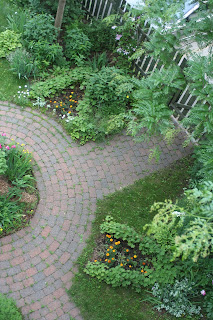Last summer, I was hoping to do a few feature blogs on beautiful, inspiring gardens as I have occasionally done in the past. Instead, I started a new job in the late spring, then was hired as a CEGEP teacher and had to do a very fast preparation for courses, and my time was eaten up by other responsibilities, so extracurricular activities like visiting, photographing and covering guest gardens was put on the backburner. Now, as of today, I have finished the last of my correcting for the semester (UQAM went very late because of the strike this spring), and I am finishing a summer class this week, then I am officially on a longer vacation than I have ever had in my adult life, while I am frantically applying for teaching posts in the hope I can do this again next year. Wish me luck!
 In the meantime, this past Sunday, our family went to our friend Olivier's for dinner. Ollie is an artist and a master gardener, and is source of both plants for my garden and lots of valuable information and advice. He is responsible for some of the best landscaping ideas that influenced the design and redesign of my garden. He has a great eye for what works well, and how to enhance the uniqueness of a garden.
In the meantime, this past Sunday, our family went to our friend Olivier's for dinner. Ollie is an artist and a master gardener, and is source of both plants for my garden and lots of valuable information and advice. He is responsible for some of the best landscaping ideas that influenced the design and redesign of my garden. He has a great eye for what works well, and how to enhance the uniqueness of a garden. 





What is particularly interesting about Ollie's garden is that Ollie lives in an apartment three stories up, and spends more time looking at the garden from above than from ground level, yet he is conscious of how it looks from the ground as well. He keeps his herbs and vegetables on his balcony overlooking the backyard, which is shared with the other residents of his building. He also has started a pot of lilac canes (from my garden) which he plans to pleach. I am introducing a bit of new vocabulary this blog. Ollie, among other things, knows a lot about trees, and he has been helping with our attempts at arborsculpting (shaping trees). This is not topiary, which is about trimming branches and leaves into shapes, but about shaping the branches and weaving and grafting branches together on the same tree, or across different trees. I learned another new word, espaliering trees, which is what Ollie and Josh did to our apple tree. After reading my last blog, Josh gave me a full explanation of espaliering trees, which was a technique used starting in Roman times, and raised to an artform in medieval Europe, in which orchards were condensed within the safe walls of keeps and castles by manipulating the branches so that the trees grow with a flat profile, or against walls. This gave the advantage of allowing for lots of fruit trees in a small space, and fitting your orchard into a walled enclosure safe from your enemies and accessible during a siege is a pretty good idea.
It also allows for some interesting decorative techniques, like making living, growing fences, as well as getting more fruit on a condensed tree. Ollie has a few examples in his yard.






 It is difficult to see the details from the photograph, but he has done some decorative organizing of branches beneath his clematis. He also takes advantage of whatever architectural features he can in his garden design, such as his back stairs, walls and fences. Given that his back yard is more sheltered and sunnier than my front yard is, he has some flowers blooming ahead of mine, such as his roses which are in full bloom, while mine are just starting to bud. His evening primroses bloomed a few days before mine seen behind the pink roses.
It is difficult to see the details from the photograph, but he has done some decorative organizing of branches beneath his clematis. He also takes advantage of whatever architectural features he can in his garden design, such as his back stairs, walls and fences. Given that his back yard is more sheltered and sunnier than my front yard is, he has some flowers blooming ahead of mine, such as his roses which are in full bloom, while mine are just starting to bud. His evening primroses bloomed a few days before mine seen behind the pink roses.
Oh, and dinner was very nice too!









No comments:
Post a Comment